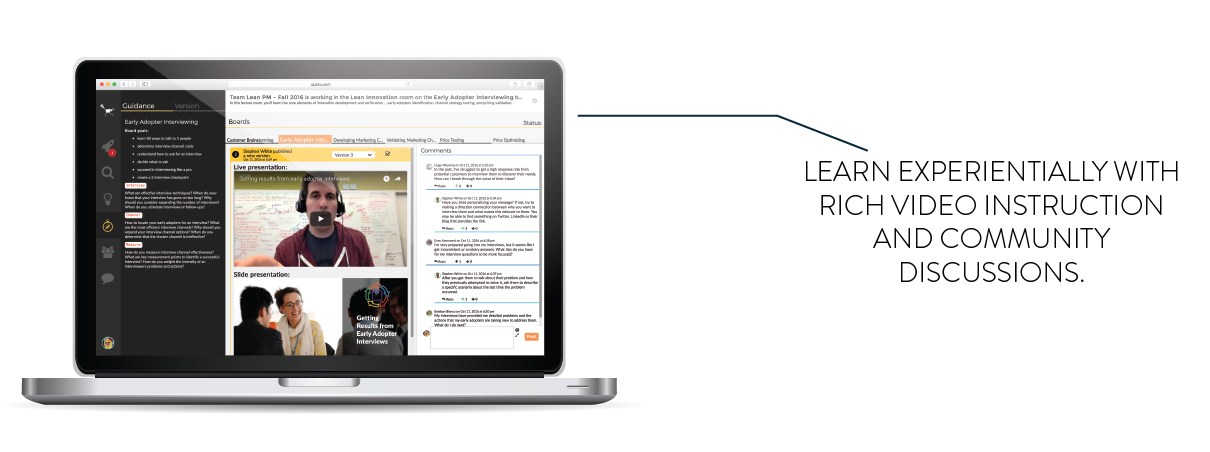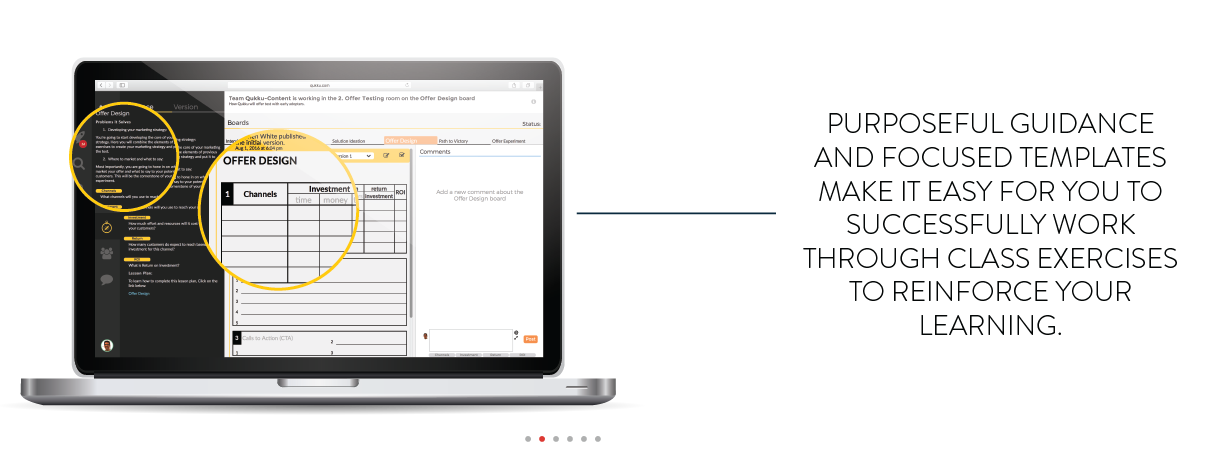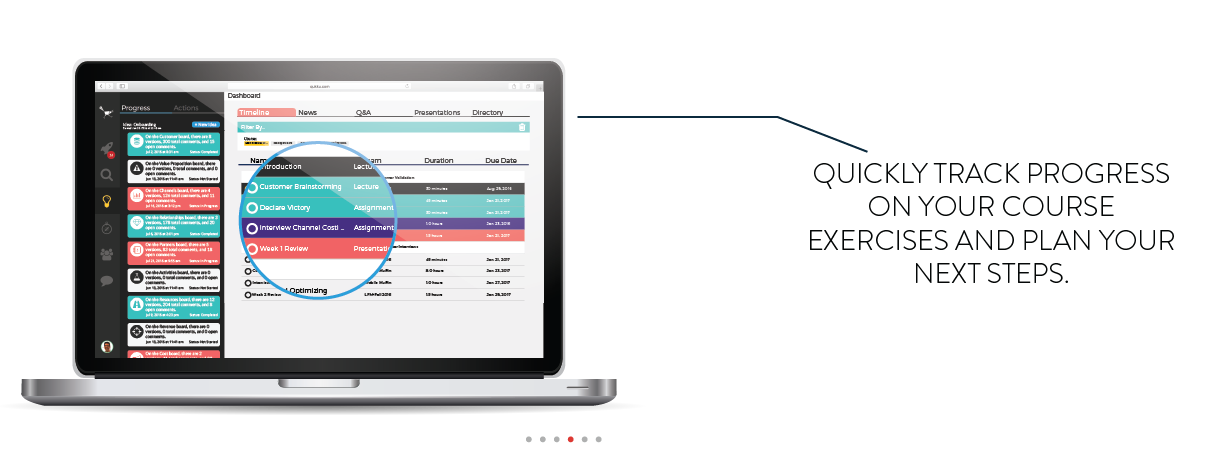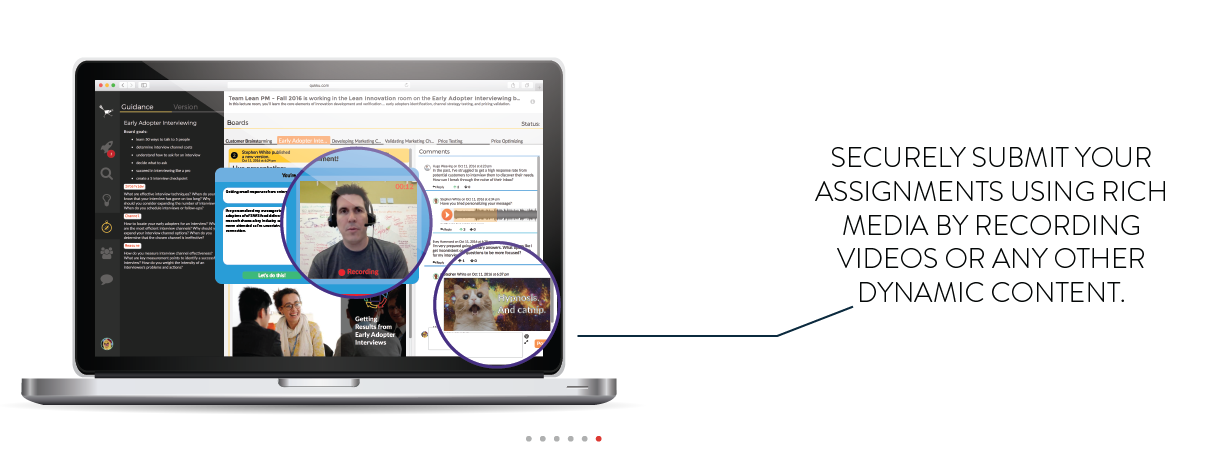
Guide INFO
Mastery Skills Gained
Customer interviewing, market segmentation, channel identification
Audience
Early stage startup team members (pre-funding through seed stage), inexperienced entrepreneurs, curious enterprise executives and employees, university students interested in learning lean methods
Pre-requisites
Accessibility
Web-based instruction with interactive exercises
On-demand with live feedback
Content
28 videos
7 activities
8 hours to complete
guide Topics
Click the + WORKSHOP NAME to see additional details
+ Idea Generation
Essential question: What is the best way to develop quality entrepreneurship ideas?
Objectives: Assess viability of startup ideas and brainstorm ideas by talking to potential customers.
Understand the 4 elements of a quality startup idea.
Discuss why it’s essential for your startup to avoid idea treadmilling.
Explore the 3 simplest ways to generate startup ideas.
Discuss how to tweak basic ideas into big ones.
Learn how to identify in a real problem worth solving for real customers.
By generating quality ideas, your startup will be established on the proper foundation of solving compelling customer-inspired problems.
If you’ve spent the past month trying to convince customers that your startup solution is the right one for them, this lesson will teach you how to quickly develop startup ideas based on real customer problems worth solving.
+ Problem Validation
Essential question: What is the best way to validate assumptions about an entrepreneurship idea?
Objectives: Develop a testable hypothesis and validate assumptions by talking to potential customers.
Learn about the 3 elements of a quality hypothesis plan.
Discuss how to develop specific, measurable hypotheses.
Identify the 5 steps for problem validation expertise.
Understand how to create a testable problem hypothesis that can be easily validated (or invalidated) with real customers.
By validating problems that your startup wants to solve through properly designed hypotheses, you’ll learn how to create rigor with your startup assumptions while also understanding a process to quickly revise those assumptions based on customer feedback.
If you’ve ever wondered how successful startups, like Tesla, Facebook and Airbnb, developed products or services that address problems that you didn’t even realize you had (and now can’t live without), this lesson will teach you how to develop a testable hypothesis and validate key assumptions about your startup by talking to potential customers.
+ Problem Generation
Essential question: What is the best way to identify problems you’re uniquely suited to solve?
Objectives: Identify problem founders can solve and think of solving problems first instead of ideas first.
Learn the 5 steps to identifying customer problems that you’re uniquely qualified to solve.
Discuss how to easily understand the needs of customers you want to serve.
Develop problems segments based on customer type.
Collaborate to generate 3 new business ideas worth solving.
By generating problems that you know your customers want you to solve and that you’re able to solve better than anyone else, you’ll learn how to focus on your customer’s problems rather than developing products that may or may not address their needs.
If you’re frustrated with the lack of early customer traction like other successful startups, this lesson will teach you the techniques to know your customers’ needs better than your customers know them and how to easily discover problems that you’ll be best suited to solve.
+ Customer Interviews
Essential question: Why are customer interviews the most powerful validation tool entrepreneurs have?
Objectives: Learn customer interview techniques and validate product design, customer market and business model through customer interviews.
Learn 4 key sales insights coming from effective customer interviews.
Understand how customer conversations provide the basis of all other business model experiments.
Compare results from the 5 types of customer validation methods.
Discuss how to avoid customer confirmation bias impacting product development.
Demonstrate an interview process that’s 400% more efficient than typical approaches.
By interviewing customers prior to developing your product or service, you’ll be able to understand the problems that they want you to solve, the negative emotions related to the problem that your customers want addressed, and what features existing solutions lack that your customers want.
If you’ve spent more than 3 months or $500 unsuccessfully reaching your first customers, this lesson will teach you why customers aren’t responding to your product or service and how you can change that within weeks.
+ Solution Generation
Essential question: What is the best way to generate solutions that alleviate negative emotions customers feel about a problem?
Objectives: Explore founders creative potential and generate solution ideas that match customer needs.
Identify the KEY QUESTION that will unlock your ability to innovatively solve your customers’ main problem.
Discuss why your customers are looking for 10x benefits over their current solutions.
Understand how to design solutions to problems people experience along with the associated negative emotions.
Develop 30 unique solutions to address real customer problems in 20 minutes.
Learn how to distill creative solutions into one of 4 competitive advantages.
By generating innovative solutions that address your customers’ main problem, you’ll be able to design a product or solution that provides clear value over existing solutions while helping your customer manage the risk of switching to your new product or service.
If you’re stuck in a rut of developing me-too products or don’t know how to clearly describe your product’s competitive difference, this lesson will teach you how to easily identify radically innovative solutions to address the negative emotions that your customers are feeling about a problem they want urgently solved.
+ Early Adopters
Essential question: How do entrepreneurs find their first customers?
Objectives: Identify early adopters for a given business and where to find early adopters, if they exist.
Discuss how finding your startup’s early adopters is essential to accelerating your product development process.
Explore how to use customer interviews to identify who your early adopters are and how to avoid wasting time on those who aren’t.
Learn the 4 easily identifiable customer segments.
Understand the 3 key traits when deciding whether to perform a customer segment pivot.
By finding, and interviewing, your early adopters, you’ll have accomplished the single-most important aspect of finding Product-Market Fit.
If you’ve been unable to generate your first sale or have been stuck with flat sales over the past 3 months, this lesson will teach you how to determine which customers are the right ones who are ready to buy your product today and which ones are wasting your time.
+ Channel Identification
Essential question: How do entrepreneurs discover the most effective channels to reach their early adopters?
Objectives: Identify which channels early adopters are easily found and calculate the cost of reaching those customers.
Explore why it’s important to develop your channel strategy early.
Learn the 5 elements that comprise a quality marketing channel.
Discuss how you can quickly determine 20 potential channels.
Validate which ones are the most effective in reaching your early adopters.
By discovering which channels are the best for you to repeatedly reach your early adopters, you’ll be able reduce your customer acquisition costs by more than 25% in 3 months.
If you’ve spent more the 30 days searching for ways to reach your customers beyond throwing money at Facebook Ads or Google AdWords, this lesson will teach you how to discover new channels where your customers are highly engaged looking for solutions to their problems and how to measure which of those channel is the most effective.











